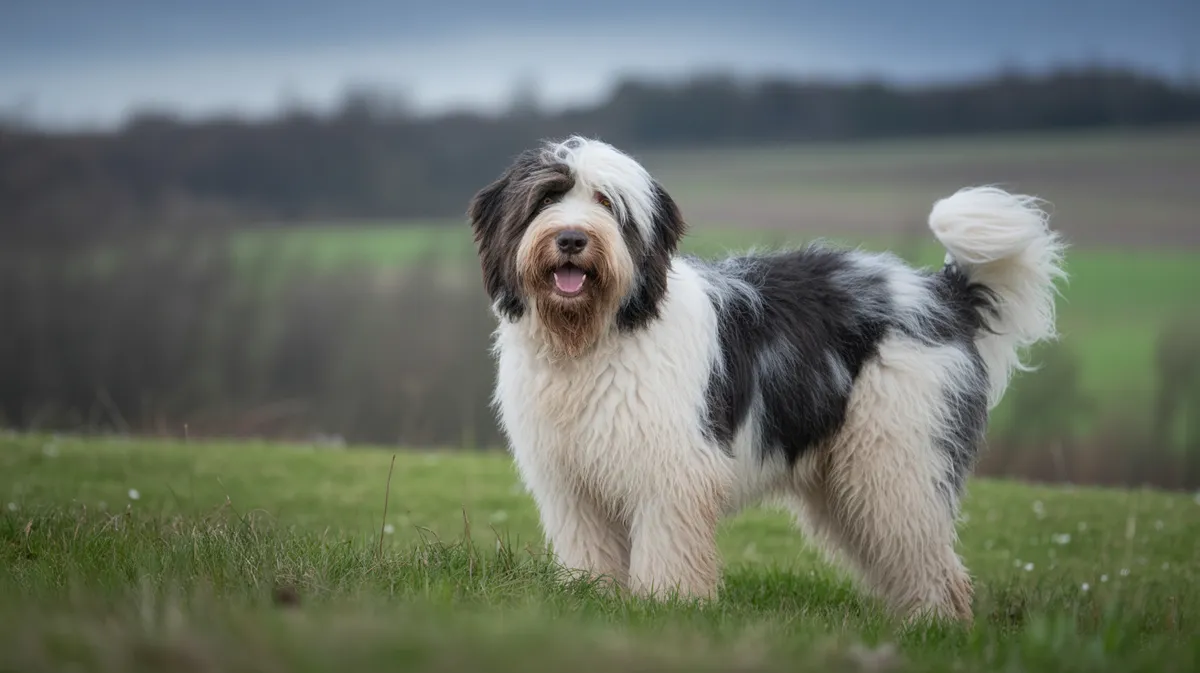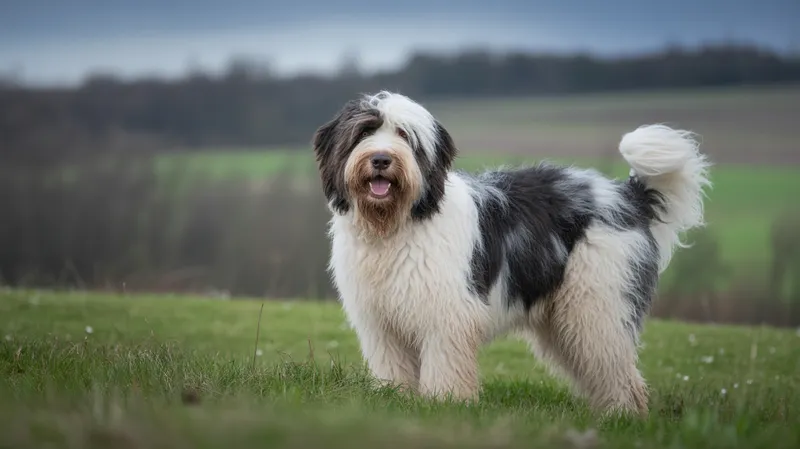
Polish Lowland Sheepdog
Canis lupus familiaris

Meet the Polish Lowland Sheepdog
The Polish Lowland Sheepdog is a medium-sized, shaggy-coated herding breed originating from Poland. Known for their intelligence and lively temperament, these dogs were traditionally used to herd and guard flocks on the Polish plains. Their thick, waterproof double coat protects them from harsh weather and gives them their distinctive, tousled appearance. Highly trainable and loyal, they excel as both working dogs and affectionate family companions.
Classification
Mammal
Habitat
Grasslands and rural farmlands
Diet
Omnivore
Lifespan
12-15 years
Conservation
Least Concern
Weight
30-50 lbs (14-23 kg)
📖Fascinating Facts
Excellent Memory
Polish Lowland Sheepdogs are famous for their remarkable memories, a trait that helped them excel in herding by remembering the location of each sheep.
Polish Heritage
This breed has a rich history in Poland, where it has been valued for centuries for its work ethic and adaptability to rural life.
Distinctive Coat
Their dense, shaggy double coat not only adds to their charm but also provides essential protection from harsh weather in their native environment.
📋Detailed Description
The Polish Lowland Sheepdog (Polski Owczarek Nizinny, PON) is a robust, medium-sized herding breed, typically standing 42–50 cm (16.5–19.5 inches) at the withers and weighing 14–23 kg (31–51 lbs). Its hallmark is a dense, shaggy double coat, consisting of a soft, insulating undercoat and a long, weather-resistant outer layer, which provides protection against Poland’s variable climate. The breed has a broad, slightly domed skull, expressive dark eyes often obscured by hair, and a strong, rectangular build that supports agility and stamina. PONs are highly intelligent, displaying keen problem-solving abilities and a strong memory, traits essential for independent herding. Their alertness and sensitivity make them excellent watchdogs, while their even temperament and loyalty foster strong bonds with human families. Socially, they are known for being both affectionate and somewhat reserved with strangers, often forming close attachments to their primary caregivers. In working contexts, PONs exhibit a natural instinct for flock management, using both visual cues and vocalizations to control livestock. Their adaptability allows them to thrive in various environments, from rural farms to urban households, provided they receive adequate mental and physical stimulation. Lifespan averages 12–15 years, with the breed generally enjoying robust health, though some lines may be predisposed to hip dysplasia and progressive retinal atrophy.
💡 Did you know?
The Polish Lowland Sheepdog is believed to be an ancestor of several other shaggy herding breeds, including the Bearded Collie.
🔬Research & Sources
Wikipedia Summary
The Polish Lowland Sheepdog, is a medium-sized, shaggy-coated, sheep dog breed native to Poland.
Last Modified: 10/27/2024
🎭Behavior & Social Structure
Polish Lowland Sheepdogs are highly active and require regular exercise to maintain their physical and mental health. Their herding heritage manifests in behaviors such as circling, nipping at heels (especially in play), and a strong desire to organize or 'herd' family members and other pets. They are quick learners but can be independent thinkers, necessitating consistent, positive reinforcement training. PONs are generally sociable with other dogs and animals if well-socialized from a young age, but their protective instincts can make them wary of unfamiliar people or situations. They thrive on routine and enjoy tasks or games that challenge their intelligence, such as scent work or advanced obedience. Daily routines often include periods of high activity interspersed with calm, watchful rest. Their feeding behavior is typical of domestic dogs, with a preference for high-quality, balanced diets; they may display food-guarding tendencies if not properly managed.
👶Reproduction & Life Cycle
The Polish Lowland Sheepdog reaches sexual maturity between 8 and 12 months, though responsible breeding is typically delayed until at least 18–24 months to ensure full physical development. The breed exhibits no marked seasonality in estrus cycles, with females coming into heat approximately every six months. Gestation lasts about 63 days. Litter sizes average 5–7 puppies, though larger litters are possible. Parental care is strong, with mothers displaying attentive nurturing and socialization behaviors. Breeders emphasize early neurological stimulation and social exposure for puppies to foster stable temperaments. Responsible breeding practices include screening for hereditary conditions such as hip dysplasia and eye disorders.
🛡️Adaptations & Survival
The PON’s dense, double-layered coat is a key adaptation, providing insulation against cold and wet weather common in the Polish lowlands. The long hair over the eyes acts as a natural visor, shielding against sun, wind, and debris while allowing sufficient vision for herding. Their compact, muscular build supports agility, endurance, and quick directional changes, essential for managing livestock. Behaviorally, their intelligence and strong memory enable them to learn complex tasks and remember flock members or boundaries over extended periods. Their acute hearing and keen sense of smell further enhance their effectiveness as working dogs and watchdogs.
🎨Cultural Significance
The Polish Lowland Sheepdog holds a special place in Polish rural heritage, historically valued for its ability to manage large flocks with minimal supervision. The breed is featured in Polish folklore and is sometimes seen as a symbol of diligence and loyalty. After World War II, the PON played a role in the reconstruction of other European herding breeds, notably contributing to the revival of the Bearded Collie. Today, the PON is celebrated in Polish dog shows and cultural events, and is recognized as a national treasure by canine organizations.
🔬Recent Research & Discoveries
Recent genetic studies have explored the PON’s relationship to other European herding breeds, confirming its close genetic ties to the Hungarian Puli and the Bearded Collie. Ongoing research focuses on mapping hereditary diseases, particularly progressive retinal atrophy and hip dysplasia, to improve breeding outcomes. Behavioral studies have highlighted the breed’s advanced problem-solving abilities and adaptability to both rural and urban environments. Conservation genetics projects are underway to ensure the maintenance of genetic diversity within the global PON population.
🎥Wildlife Videos

Sheepdog to a Shepherd
Disclaimer: This video content is intended for educational purposes only. This is not and cannot be considered professional ...
Humilitas First

10 Rare Dog | Breeds with Unique Coat That You’ve Never Heard of Before
Discover the fascinating world of rarest dog breeds with unique coats that stand out for their beauty and history! From the corded ...
Wild Planet Tv

2020 Diploma Final Film
This film was made by Jasmine and Louis in October and November 2020 during the 8 week practical section of their SCQF 'Level ...
wildlifefilmschoolUK

Top 8 Shaggy Dog Breeds
Households prepping for a new pet are likely to consider many different factors about a breed before deciding which one to bring ...
Just6F

Today learn - Rottweiler | Labrador Retriever | Pyrenean Shepherd | Dogs🌍| Beautiful Earth
Shorts #Viralvideos #Nature #earth Welcome to the new Nature and Earth Video-: Today learn - Rottweiler | Labrador Retriever ...
Beautiful Earth
🌍Habitat Information
The Polish Lowland Sheepdog typically inhabits Grasslands and rural farmlands environments. Polish Lowland Sheepdogs have adapted to their environments with specialized features and behaviors.
Primary Habitat:
Grasslands and rural farmlands
More detailed habitat information will be available soon.
🛡️Conservation Status
The Polish Lowland Sheepdog is currently classified as Least Concern. Conservation efforts are crucial for preserving this species for future generations.
Common Threats:
- 🏠Habitat loss and fragmentation
- 🌡️Climate change impacts
- 🎯Hunting and poaching
- 🏭Human-wildlife conflict
⚠️Threats & Conservation Challenges
Currently, the Polish Lowland Sheepdog is not considered at risk, with stable populations maintained through dedicated breed clubs and enthusiasts. However, challenges include the risk of genetic bottlenecks due to a limited breeding pool, particularly outside Poland, and the potential for hereditary health issues if breeding practices are not rigorously managed. Urbanization and the decline of traditional pastoralism have reduced the breed’s working roles, increasing reliance on companion and show homes. There is a need for ongoing health screening and genetic diversity monitoring to preserve the breed’s vitality.
🔬Scientific Classification
Scientific Name
Canis lupus familiaris
Classification Hierarchy
🔍 About Taxonomic Classification
Taxonomic classification is a hierarchical system used by scientists to classify and organize living organisms based on shared characteristics and evolutionary relationships.
The system moves from broad categories (Kingdom) to increasingly specific ones, with each animal's scientific name typically consisting of its Genus and species.
📝Community Notes
Share your observations and insights about the Polish Lowland Sheepdog with our community of wildlife enthusiasts.
Join Our Community
Sign in to share your observations and connect with fellow wildlife enthusiasts.
Sign In to ContributeNo community notes yet
Be the first to share your observations about the Polish Lowland Sheepdog!
Explore Polish Lowland Sheepdog
Select a tab above to learn more about this amazing animal.
📸Photo Gallery
No photos available for this animal yet.
🌟Discover More Wildlife
Continue your journey of discovery with more fascinating animals from our database
